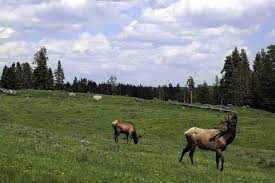FAO‘s Global forest resources assessment provides regular estimates of the state of the world‘s forests, their extent and health, and the status of their socio-economic and environmental functions (FAO 2010).
Rangelands extend over all latitudes, and are usually characterized by low biomass production due to constraints related to soil, temperature and water availability.
Forests
In 2010, forests covered approximately 4 billion ha. Deforestation arising mainly from the conversion of tropical forests to agricultural land has recently shown signs of decreasing, but still continues at an alarming rate.
Around 13Mha (million hectare) of forest were converted to other uses or lost through natural causes each year in the last decade, compared with 16Mha per year in the 1990s.
However, during the last decade, the net reduction in forest areas has been significantly limited by large scale tree planting estimated at 5.2 Mha per year during the first decade of the 21st century.
Read Also : Complete List of Recyclable Wastes (Waste Recyclables)
Net losses of forested land were concentrated in South America, sub- Saharan Africa, Southeast Asia and Oceania, while the US, India, China, Russia and several European countries showed net gains in forested land.
Primary forests account for 36 percent of forest area, but have decreased by more than 40Mha since 2000. Reduction in primary forests may have important impacts on forest biodiversity.
Importance of Forests
Forests play a crucial role in the hydrological cycle, which is why they must be taken into consideration when analyzing water issues at landscape level. They capture and store water, prevent soil erosion, and serve as natural water purification systems.
Forests influence the amount of water availability, regulate surface and groundwater flows, and ensure high water quality. Moreover, forests and trees contribute to the reduction of water-related risks such as landslides, local floods and droughts, and help prevent desertification and salinization.

Forested watersheds and wetlands supply three-quarters of the world‘s accessible fresh water to satisfy domestic, agricultural, industrial and ecological needs (FAO 2008).
Rangelands
Rangelands extend over all latitudes, and are usually characterized by low biomass production due to constraints related to soil, temperature and water availability.
They cover some 25 percent of the global land area, and include the drylands of Africa (66 percent of the total continental land area) and the Arabian Peninsula, the steppes of Central Asia and the highlands of Latin America (Nori and Neely 2009).
Vegetation is mostly dominated by natural plant communities of perennial and annual species, including grasses, shrubs and trees.
By their nature, rangelands are fragile ecosystems and when mismanaged readily result in degradation, loss of biodiversity and water retention capacity, carbon emissions and reduced productivity.
The extent and trends in rangelands are hard to assess. Global statistics indicate that the total area of rangelands was 3.43 billion ha in 2000, and decreased slightly to 3.36 billion ha by 2008.
The reasons for these minor changes cannot be easily identified, though may include poor data, desertification and encroachment of agriculture.
Large-scale conversion of drier grasslands to crops and inappropriate management has had unfortunate consequences, such as the dust bowl of the Great Plains of the USA in the 1920s and 1930s.
In the mid-20th century, drylands were widely cultivated in the USSR, but crop production was also unsustainable in that region (Boonman and Mikhalev 2005) and these lands are now reverting to rangelands.
Importance of Rangelands
The contribution that rangelands make to the maintenance of ecosystem functions and biodiversity is important. In addition to providing feed for livestock, they play an important role as a habitat for wildlife, for water retention and for the conservation of plant genetic resources.
The flora of rangelands is rich: about 750 genera and 12 000 grass species. These ecosystems are also important for the maintenance of fauna; for example, grasslands contain 11 percent of the world‘s endemic bird areas (White et al. 2000: 40), and contribute to the maintenance of pollinators and other insects that have important regulating functions.
Ecosystem benefits, especially regulating services such as water infiltration and purification, climate regulation (e.g. carbon sequestration) and pollination, have begun to be assigned an economic value, and systematic data-gathering in rangelands of both developed and developing countries should be a global priority.
Challenges facing Rangeland and their Users
Over 600 million people depend on rangelands for their livelihoods (FAO 2011). Pastoral societies have developed strategies that continuously adapt to limited, highly variable and unpredictable resource endowments (e.g. by migratory livestock rearing), but both the rangelands and their users are also vulnerable to the changes brought by demographic pressure, conversion of cropland and climate change.
Fluctuations in rainfall and drought are recurring problems in rangelands for example, 70 million people in the Horn of Africa, many of whom are pastoralists, suffer from long-term chronic food insecurity (FAO 2000). Table 1: lists major pastoral systems and illustrates how they evolve with time.
Table 1 Regional zonation of pastoral systems
| Zone | Main Species | Status |
| sub-Saharan Africa | Cattle, camel, sheep, goats | Declining due to advancing agriculture |
| Mediterranean | Small ruminants | Declining due to enclosure and advancing agriculture |
| Near East and South- Central Asia | Small ruminants | Declining in some areas due to enclosure and advancing agriculture |
| India | Cattle, camel, sheep, goats | Declining due to advancing agriculture but peri-urban livestock production |
In summary, forests play a crucial role in the hydrological cycle. The contribution that rangelands make to the maintenance of ecosystem functions and biodiversity is important.
Net losses of forested land were concentrated in South America, sub-Saharan Africa, Southeast Asia and Oceania.
Read Also : Top Wastewater Management Companies in the World
Forests influence the amount of water availability, regulate surface and groundwater flows, and ensure high water quality. Fluctuations in rainfall and drought are recurring problems in rangelands for example, 70 million people in the Horn of Africa, many of whom are pastoralists, suffer from long-term chronic food insecurity.

